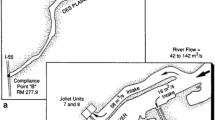Abstract
The thermally induced biological effects of power plants with once-through cooling systems can be evaluated in a logical, scientifically defensible manner. First, we combined a near-field integral model (the Shirazi-Davis model) with a far-field model (the Okubo-Pritchard model) to predict the fields of excess temperature and velocity associated with a hypothetical power plant sited on a river and an estuary, and to establish the time-excess temperature exposure histories resulting from the interaction of an assumed distribution of organisms with these fields. Next, we developed a new thermal response model to assess the thermal effects of these exposures on these organisms.
Our thermal response model can be used with data from existing and proposed power plants to estimate what fraction of plankton in waters contiguous to the plant will be exposed to thermal doses greater than those that cause death at any stated level. The model can also be used to aid in the design of once-through cooling systems to keep the mortality rate caused by thermal stresses below any designated threshold. The inputs to the model are the frequency distribution of time-excess temperature histories experienced by particular plankton (the Representative Important Species), thermal resistance curves for those organisms, and the spatial and temporal variations of the natural temperature of the receiving waters.
To illustrate, we applied our thermal response model to three important aquatic environments of New York State, Long Island Sound, the lower Hudson River, and Lake Ontario. The Representative Important Species were identified for each of these environments and the thermal resistance data for their early (entrainable) life stages were reviewed. Fromall of the thermal resistance data available for any of the entrainable species composing these three communities, we constructed “community thermal resistance curves” and showed how they could be combined in graphic form with the distribution of thermal doses computed from the physical models and an assumed distribution of organisms in the receiving waters. For each community it appeared that the most sensitive organisms were the ichthyoplankton and juvenile fish; therefore, protection of these organisms from thermal stress should protect the entrainable populations as a whole.
Finally, we made several recommendations for future research so that the full management potential of our approach can be achieved.
Similar content being viewed by others
Literature cited
Brett, J. R. 1952. Temperature tolerance in young pacific salmon, genus Oncorhunchus. J. Fish. Res. Board Can. 11(6):265–323.
Dunn, W. E., A. J. Policastro, and R. A. Paddock. 1975a. Surface thermal plumes: evaluation of mathematical models for the near and complete field. Argonne National Lab. ANL/WR-75-3 Part 1, Heat rejection and utilization (UC-12). 397 pp.
1975b. Surface thermal plumes: evaluation of mathematical models for the near and complete field. Argonne National Lab. ANL/WR-75-3 Part 2, Heat rejection and utilization (UC-12). 531 pp.
EPA. 1973. Water quality criteria 1972. Ecological Research Series, EPA-R3-73-033. 594 pp.
Federal Water Polution Control Acts. 1972. Amendments of 1972. Public Law 92–500. 89 pp.
Hoff, J. G., and J. R. Westman. 1966. The temperature tolerances of three species of marine fishes. J. Mar. Res. 24(2):131–140.
Hoss, D. E., W. F. Hettler, and L. C. Coston. 1974. Effects of thermal shock on larval estuarine fish-ecological implications with respect to entrainment in power plant cooling systems. Pages 357–371in J. H. S. Blaxter, ed. The early life history of fish. Springer-Verlag, Berlin.
Jirka, G. H., G. Abraham, and D. R. F. Harleman. 1975. An assessment of techniques for hydrothermal prediction. Ralph M. Parsons Lab. Rept. 203, M.I.T., U.S. Nuclear Regulatory Comm. Rept. C00-2374-2. 403 pp.
Kennedy, V. S., W. H. Rosenburg, M. Castagna, and J. A. Mihursky. 1974.Mercenaria mercenaria (Mollusca: Bivalvia): temperature-time relationships for survival of embryos and larvae. U.S. Fish. Bull. 72(4): 1160–1166.
NEPA. 1969. As amended, PL91-90, 42USC 4321-4347, 1 Jan. 1970, as amended by PL94-83, 9 Aug. 1975.
Pritchard, D. W. 1960. The application of existing oceanographic knowledge to the problem of radioactive waste disposal into the sea.in Disposal of radioactive wastes. Vol. 2. International Atomic Energy Agency, Vienna.
Prych, E. A. 1972. A warm water effluent analysis as a buoyant surface jet. Swedish Meteorological and Hydrological Institute, Series Hydroli, No. 21. 64 pp.
Schubel, J. R., and B. C. Marcy, Jr., eds. 1978. Power plant entrainment: a biological assessment. Academic Press, New York. 271 pp.
Shirazi, M. A., and L. R. Davis. 1974. Workbook of thermal plume prediction. Vol. 2. Surface discharge. Environmental Protection Tech. Series, EPA-R2-72-005b. 430 pp.
- 1976. Analysis of buoyant surface jets. J. Heat Transfer 98(3): 8 pp.
Stolzenbach, K. D. 1976. A discussion of research needs related to the evaluation of thermal effects caused by heated discharges from electric power generating stations. Prepared for the New York State Energy Research and Development Authority. 51 pp.
Author information
Authors and Affiliations
Rights and permissions
About this article
Cite this article
Carter, H.H., Schubel, J.R., Wilson, R.E. et al. Thermally induced biological effects caused by once-through cooling systems: A rationale for evaluation. Environmental Management 3, 353–368 (1979). https://doi.org/10.1007/BF01867442
Issue Date:
DOI: https://doi.org/10.1007/BF01867442




